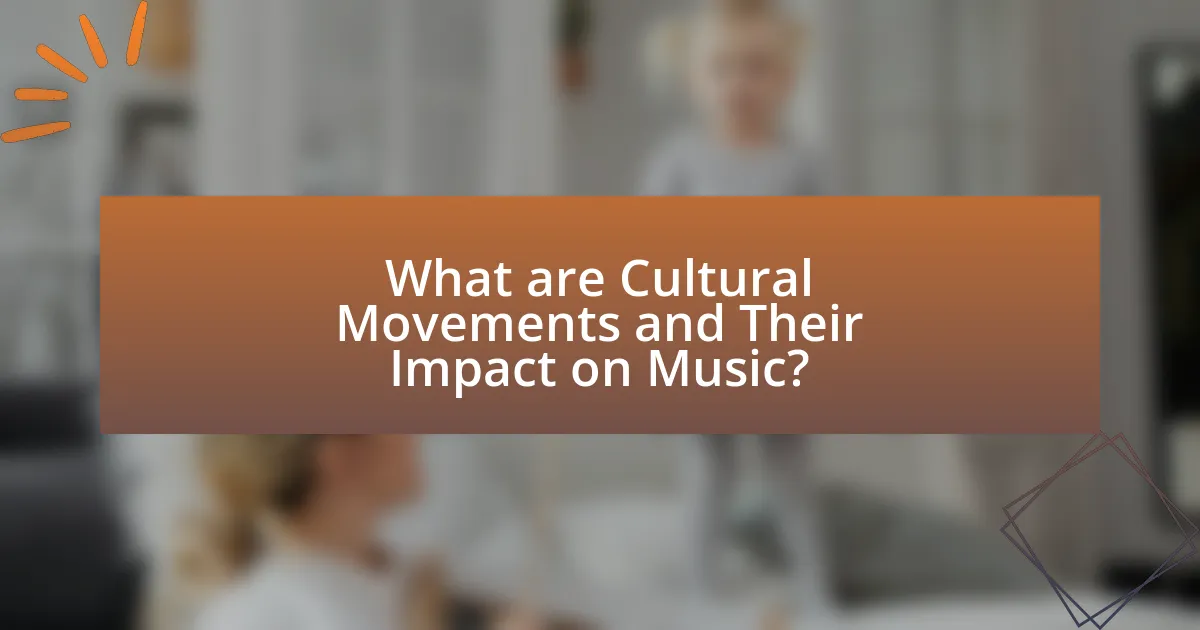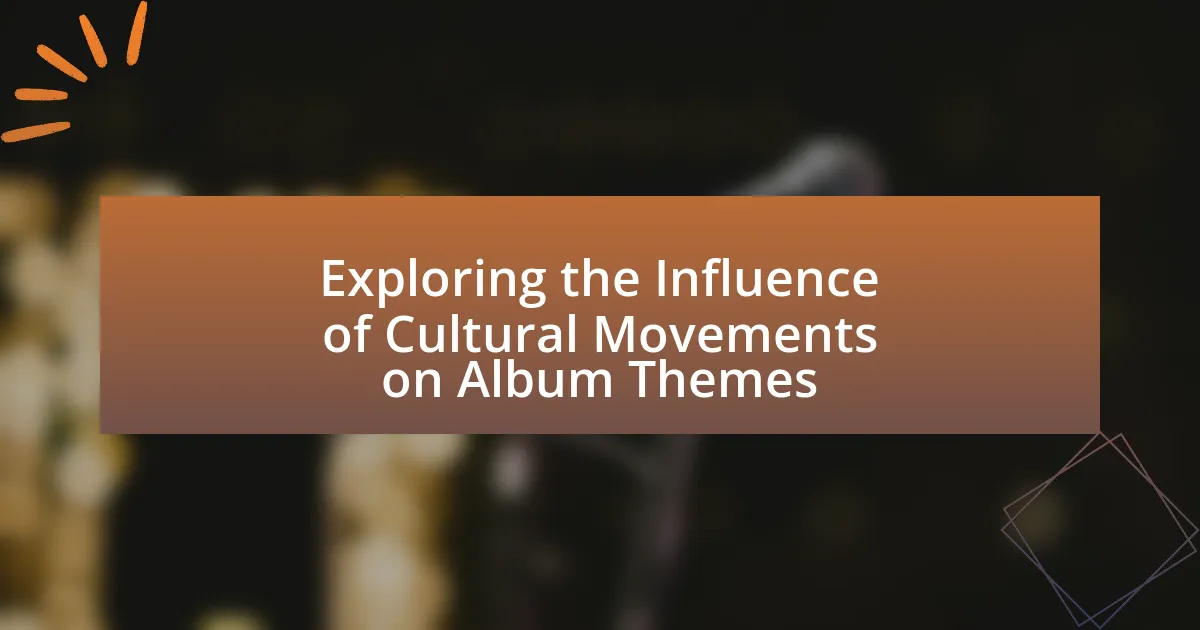The article explores the influence of cultural movements on album themes, highlighting how collective social phenomena shape music’s themes, styles, and messages. It examines historical examples, such as the Civil Rights Movement and the Punk Movement, illustrating their impact on artists and the creation of protest songs and anthems. The analysis emphasizes the importance of understanding the relationship between cultural movements and music, revealing how societal changes drive artistic expression and thematic depth in albums. Additionally, it discusses contemporary cultural movements and their effects on current music, providing insights into how artists can authentically reflect cultural themes in their work.

What are Cultural Movements and Their Impact on Music?
Cultural movements are collective social phenomena that reflect shared beliefs, values, and practices within a society, significantly influencing music by shaping its themes, styles, and messages. For instance, the Civil Rights Movement in the 1960s inspired artists like Nina Simone and Sam Cooke to create powerful anthems that addressed social justice and equality, such as “Mississippi Goddam” and “A Change Is Gonna Come.” Similarly, the Punk Movement of the 1970s challenged mainstream norms, leading to the emergence of bands like The Sex Pistols and The Clash, whose music conveyed anti-establishment sentiments. These examples illustrate how cultural movements not only inspire musical expression but also serve as a vehicle for social commentary and change, reinforcing the interconnectedness of society and music.
How do cultural movements shape artistic expression in music?
Cultural movements significantly shape artistic expression in music by influencing themes, styles, and the overall message conveyed by artists. For instance, the Civil Rights Movement in the 1960s inspired musicians like Nina Simone and Sam Cooke to create powerful anthems that addressed social justice and equality, such as “Mississippi Goddam” and “A Change Is Gonna Come.” These songs not only reflected the struggles of the time but also galvanized listeners, demonstrating how cultural contexts can drive musical innovation and expression. Additionally, the punk movement of the 1970s challenged mainstream norms, leading to a raw, rebellious sound that expressed discontent with societal issues, as seen in the works of bands like The Sex Pistols. Thus, cultural movements serve as catalysts for artistic expression in music, shaping the narratives and styles that resonate with audiences.
What historical examples illustrate the influence of cultural movements on music themes?
The Civil Rights Movement significantly influenced music themes in the 1960s, with artists like Sam Cooke and Nina Simone addressing social justice and racial equality in their songs. For instance, Cooke’s “A Change Is Gonna Come” became an anthem for the movement, reflecting the struggles and aspirations of African Americans during that era. Similarly, the counterculture movement of the 1960s, characterized by anti-war sentiments and a push for peace, inspired musicians like Bob Dylan and Joan Baez to create protest songs such as “Blowin’ in the Wind,” which questioned societal norms and advocated for change. These examples illustrate how cultural movements directly shaped the thematic content of music, making it a powerful vehicle for social commentary and change.
How do cultural movements reflect societal changes in music?
Cultural movements reflect societal changes in music by serving as catalysts for new genres, themes, and expressions that resonate with the prevailing social, political, and economic climates. For instance, the Civil Rights Movement in the 1960s significantly influenced music, leading to the emergence of protest songs that addressed racial inequality and social justice, exemplified by artists like Sam Cooke with “A Change Is Gonna Come.” Similarly, the punk movement of the 1970s emerged as a reaction to political disillusionment and economic hardship, characterized by raw, rebellious music that challenged the status quo. These movements not only shaped the sound and style of music but also provided a voice for marginalized communities, reflecting their struggles and aspirations. Thus, the evolution of music is intricately linked to the cultural movements that encapsulate the zeitgeist of their times.
Why is it important to analyze the relationship between cultural movements and album themes?
Analyzing the relationship between cultural movements and album themes is important because it reveals how societal changes influence artistic expression. Cultural movements often reflect the values, struggles, and aspirations of a society, which in turn shape the themes and messages conveyed in music albums. For instance, the civil rights movement in the 1960s inspired numerous albums that addressed racial injustice and equality, such as Nina Simone’s “Mississippi Goddam.” This connection provides insight into the historical context of the music, allowing listeners and scholars to understand the deeper meanings behind the lyrics and compositions. By examining this relationship, one can appreciate how music serves as both a reflection of and a response to cultural dynamics, thereby enriching the understanding of both the art form and the society from which it emerges.
What insights can be gained from understanding this relationship?
Understanding the relationship between cultural movements and album themes reveals how societal changes shape artistic expression. This insight highlights that albums often reflect the values, struggles, and aspirations of their time, allowing listeners to connect with broader cultural narratives. For example, the punk movement in the 1970s influenced albums that addressed themes of rebellion and anti-establishment sentiments, as seen in works like The Clash’s “London Calling.” Such connections demonstrate that music serves not only as entertainment but also as a historical document, providing context for the cultural climate during its creation.
How does this analysis enhance our appreciation of music?
This analysis enhances our appreciation of music by revealing the intricate connections between cultural movements and album themes. Understanding how societal changes, such as the civil rights movement or the rise of feminism, influence musical expression allows listeners to grasp the deeper meanings behind lyrics and compositions. For instance, albums like Marvin Gaye’s “What’s Going On” reflect the social upheaval of the 1960s and 1970s, providing context that enriches the listening experience. By recognizing these influences, audiences can engage with music on a more profound level, appreciating not just the sound but also the historical and cultural narratives that shape it.

What are the Key Cultural Movements Influencing Album Themes?
Key cultural movements influencing album themes include the Civil Rights Movement, the Feminist Movement, and the LGBTQ+ Rights Movement. The Civil Rights Movement of the 1960s inspired numerous artists to address racial inequality and social justice, leading to powerful albums like Marvin Gaye’s “What’s Going On,” which reflects the struggles and aspirations of African Americans. The Feminist Movement has shaped themes around gender equality and empowerment, evident in works like Alanis Morissette’s “Jagged Little Pill,” which explores women’s experiences and societal expectations. Additionally, the LGBTQ+ Rights Movement has influenced artists to express identity and love freely, as seen in albums like Frank Ocean’s “Blonde,” which candidly addresses sexuality and personal struggles. These movements have significantly shaped the lyrical content and artistic direction of many albums, reflecting societal changes and cultural dialogues.
Which cultural movements have had the most significant impact on music albums?
The cultural movements that have had the most significant impact on music albums include the counterculture movement of the 1960s, punk rock in the 1970s, and hip-hop from the 1980s onward. The counterculture movement, characterized by anti-establishment sentiments and social change, influenced iconic albums like The Beatles’ “Sgt. Pepper’s Lonely Hearts Club Band,” which reflected the era’s ideals and experimentation. Punk rock, emerging as a reaction to mainstream music, led to raw and politically charged albums such as The Clash’s “London Calling,” which addressed social issues and rebellion. Hip-hop, originating in marginalized communities, has shaped numerous albums like Public Enemy’s “It Takes a Nation of Millions to Hold Us Back,” which tackled systemic racism and empowerment, demonstrating the genre’s cultural significance and influence on societal narratives.
How did the counterculture movement of the 1960s influence album themes?
The counterculture movement of the 1960s significantly influenced album themes by promoting messages of social change, anti-establishment sentiments, and personal freedom. Artists like Bob Dylan and The Beatles incorporated themes of protest, love, and experimentation in their music, reflecting the era’s desire for cultural and political transformation. For instance, Dylan’s “The Times They Are a-Changin'” became an anthem for civil rights and anti-war movements, while The Beatles’ “Sgt. Pepper’s Lonely Hearts Club Band” embraced psychedelic experiences and a break from traditional norms. This shift in thematic focus in albums mirrored the broader societal upheaval and the quest for identity during the 1960s, making music a vehicle for expressing the values and aspirations of the counterculture.
What role did the punk movement play in shaping music themes?
The punk movement significantly influenced music themes by promoting anti-establishment sentiments, individualism, and raw emotional expression. Emerging in the mid-1970s, punk rock artists like the Sex Pistols and The Ramones used their music to challenge societal norms and critique political systems, which resonated with disillusioned youth. This genre emphasized simplicity in musical structure and lyrics, often addressing themes of rebellion, social issues, and personal freedom. The impact of punk is evident in subsequent genres, such as grunge and pop-punk, which adopted its ethos of authenticity and resistance against mainstream culture.
How do contemporary cultural movements affect current album themes?
Contemporary cultural movements significantly shape current album themes by influencing artists’ lyrical content, musical styles, and overall messaging. For instance, the Black Lives Matter movement has prompted many musicians to address issues of racial injustice and social equity in their work, leading to albums that reflect activism and awareness. A notable example is Kendrick Lamar’s “To Pimp a Butterfly,” which explores themes of race, identity, and systemic oppression, directly correlating with the cultural discourse surrounding racial equality. Additionally, the rise of environmentalism has led artists like Billie Eilish to incorporate themes of climate change and sustainability into their music, as seen in her album “When We All Fall Asleep, Where Do We Go?” This alignment with contemporary cultural movements not only resonates with audiences but also drives the evolution of musical genres and artistic expression.
What are the characteristics of modern cultural movements in music?
Modern cultural movements in music are characterized by diversity, digital accessibility, and social activism. These movements reflect a wide range of genres and influences, showcasing the blending of styles such as hip-hop, electronic, and indie rock. The rise of streaming platforms has democratized music distribution, allowing artists from various backgrounds to reach global audiences without traditional gatekeepers. Additionally, contemporary movements often emphasize social issues, with artists using their platforms to advocate for change, as seen in genres like protest music and movements such as Black Lives Matter influencing lyrical content. This intersection of music and activism highlights the role of cultural movements in shaping not only sound but also societal discourse.
How do social media and technology influence these movements?
Social media and technology significantly influence cultural movements by facilitating rapid communication and widespread dissemination of ideas. Platforms like Twitter and Instagram enable activists to share messages, organize events, and mobilize supporters instantly, as seen in movements like Black Lives Matter, which gained momentum through viral hashtags and online campaigns. Additionally, technology allows for the creation of multimedia content that can amplify messages, such as videos and live streams, which engage a broader audience and foster community. According to a study by the Pew Research Center, 69% of adults in the U.S. use social media, highlighting its role as a primary tool for information sharing and community building in contemporary movements.

How Can We Analyze Album Themes Through the Lens of Cultural Movements?
Analyzing album themes through the lens of cultural movements involves examining how societal changes, values, and events influence the content and style of music. Cultural movements, such as the Civil Rights Movement or the Punk Rock movement, often shape the themes of albums by reflecting the struggles, aspirations, and sentiments of the time. For instance, albums like Marvin Gaye’s “What’s Going On” directly address social issues and resonate with the Civil Rights Movement, showcasing how music can serve as a commentary on cultural dynamics. This analysis can be supported by examining lyrical content, album artwork, and the historical context surrounding the release, which collectively illustrate the interplay between music and cultural movements.
What methods can be used to study the influence of cultural movements on album themes?
Qualitative analysis, such as thematic analysis and content analysis, can be used to study the influence of cultural movements on album themes. Thematic analysis allows researchers to identify and interpret patterns within album lyrics and artwork that reflect cultural contexts, while content analysis quantifies the presence of specific themes or motifs related to cultural movements. For example, studies have shown that the rise of social movements, like civil rights or feminism, often correlates with lyrical content that addresses social justice, as seen in albums from artists like Bob Dylan or Beyoncé. This correlation provides concrete evidence of how cultural movements shape artistic expression in music.
How can lyrical analysis reveal cultural influences in albums?
Lyrical analysis can reveal cultural influences in albums by examining the themes, language, and references within the lyrics that reflect societal values, historical events, and cultural movements. For instance, albums that address social justice issues often incorporate language and imagery that resonate with contemporary movements, such as civil rights or feminism, indicating the artist’s engagement with these cultural contexts. An example is Kendrick Lamar’s “To Pimp a Butterfly,” which addresses systemic racism and personal identity, reflecting the Black Lives Matter movement and the historical context of African American struggles. This connection between lyrics and cultural influences allows listeners to understand the broader societal implications of the music, demonstrating how artists respond to and shape cultural narratives through their work.
What role does visual art and album design play in reflecting cultural movements?
Visual art and album design serve as critical mediums for expressing and reflecting cultural movements by visually encapsulating the themes, emotions, and ideologies of the time. For instance, the psychedelic art associated with the 1960s counterculture movement, exemplified by album covers like The Beatles’ “Sgt. Pepper’s Lonely Hearts Club Band,” visually represented the era’s embrace of experimentation and liberation. This connection between visual aesthetics and cultural context is further evidenced by the punk rock movement, where album designs often featured raw, DIY aesthetics that mirrored the anti-establishment sentiments of the time, such as the cover of The Sex Pistols’ “Never Mind the Bollocks.” These examples illustrate how visual art and album design not only complement the music but also serve as a historical record of societal values and shifts, making them integral to understanding cultural movements.
What are some examples of albums that exemplify this analysis?
Albums that exemplify the influence of cultural movements on themes include “What’s Going On” by Marvin Gaye, which reflects the social upheaval of the 1960s and 1970s, addressing issues like civil rights and environmentalism. Another example is “The Miseducation of Lauryn Hill,” which draws from the Black feminist movement and explores themes of identity and empowerment. Additionally, “OK Computer” by Radiohead captures the anxieties of modern technology and globalization, resonating with the late 1990s cultural climate. Each of these albums showcases how cultural movements shape artistic expression and thematic depth in music.
How do specific albums reflect the cultural movements of their time?
Specific albums reflect the cultural movements of their time by encapsulating the social, political, and emotional landscapes prevalent during their release. For example, Bob Dylan’s “The Times They Are a-Changin'” mirrors the civil rights movement and anti-war sentiments of the 1960s, with its lyrics advocating for social change and justice. Similarly, Nirvana’s “Nevermind” captures the disillusionment of Generation X in the early 1990s, addressing themes of alienation and societal pressures, which resonated with the youth culture of that era. These albums serve as historical artifacts, illustrating how music can both influence and reflect the zeitgeist, thereby providing insight into the collective consciousness of their respective periods.
What lessons can be learned from these examples for future music creation?
Future music creation can benefit from understanding the interplay between cultural movements and album themes. By analyzing past examples, artists can recognize how societal changes, such as civil rights movements or technological advancements, have shaped musical expression and thematic content. For instance, the 1960s counterculture influenced artists like Bob Dylan and The Beatles, leading to songs that addressed social issues and personal freedom. This historical context demonstrates that aligning music with contemporary cultural narratives can enhance relevance and resonance with audiences. Therefore, future creators should actively engage with current cultural dialogues to inform their artistic direction and thematic choices.
What practical tips can artists use to incorporate cultural influences into their album themes?
Artists can incorporate cultural influences into their album themes by conducting thorough research on the cultural elements they wish to explore, such as traditions, stories, and music styles. This research can involve studying historical contexts, engaging with community members, and analyzing existing works that reflect those cultural aspects. For example, artists can draw inspiration from specific cultural narratives or folklore, which can provide a rich thematic foundation for their music. Additionally, collaborating with artists from the culture being represented can ensure authenticity and depth, as seen in projects like “The Lion King: The Gift,” where various African artists contributed to the album, enhancing its cultural representation. By integrating these elements thoughtfully, artists can create albums that resonate with diverse audiences while honoring the cultural influences they draw from.
How can artists stay informed about current cultural movements?
Artists can stay informed about current cultural movements by actively engaging with diverse media sources, attending cultural events, and participating in community discussions. Consuming a variety of content, such as news articles, social media platforms, podcasts, and documentaries, allows artists to gain insights into emerging trends and societal shifts. Additionally, attending art exhibitions, music festivals, and cultural conferences provides firsthand exposure to contemporary ideas and practices. Engaging in conversations with peers and audiences fosters a deeper understanding of the cultural landscape. Research indicates that artists who immerse themselves in these activities are more likely to create work that resonates with current societal themes, as seen in the evolution of music genres influenced by social movements.
What strategies can artists employ to authentically reflect cultural themes in their work?
Artists can authentically reflect cultural themes in their work by engaging deeply with the cultural context they wish to represent. This involves thorough research into the history, traditions, and values of the culture, allowing artists to create informed and respectful representations. For instance, artists can collaborate with cultural experts or community members to gain insights and ensure accuracy in their portrayals. Additionally, incorporating traditional techniques or materials specific to the culture can enhance authenticity. A notable example is the use of indigenous instruments in contemporary music, which not only honors the cultural heritage but also introduces it to new audiences. By prioritizing genuine representation and fostering community connections, artists can create works that resonate meaningfully with cultural themes.
